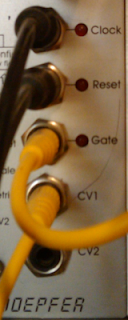I stumbled upon this interesting site last week; Tone's Analog Synthesizer Projects and Products. You can find it at
http://synovatron.blogspot.com/
The overall site looks like a good start for everyone who is busy with, or starting on eurorack synthesizer DIY-ing and is operated by Tony Steventon, a UK electronics design engineer with a long interest in synths.
"Like most ideas it came out of trying to solve problems..." he wrote to me "... I could not fit either the jack sockets or bracketed pots on to standard 0.1" perfboard and came up with this idea over a year ago".
 He continues "...several people have expressed an interest in learning how to take an idea through to a design and onto a prototyped module which I am quite tempted to do as a future 'learning' page on my blog..." "...
He continues "...several people have expressed an interest in learning how to take an idea through to a design and onto a prototyped module which I am quite tempted to do as a future 'learning' page on my blog..." "...I am working on my CV Tools module at the moment, which I have prototyped using my kits, but when that is ready for manufacture I am happy to consider some more ideas, I already have four promising ideas which may get developed either on my own or in collaboration with the idea originators."
Along with selling different DIY sets and prototyping kits, you can also order additional components for reasonable prices here. Listed are various Control pots (50k linear supplied as standard but 10k linear, 100k linear, 1M logarithmic or a mixture are available upon request), Pot mounting brackets, Decoupling capacitors, 16-pin headers, 3.5mm jack sockets, Red/green 3mm 2mA LEDs, TL084 quad op-amps (DIL), 14-pin IC sockets, 16mm soft-touch knobs (red, grey, orange, green, white, blue, yellow pointers), 10uF 16V electrolytic capacitors, 100nF ceramic capacitors, Headers - single, double, straight, right-angle, DPDT toggle switches to fit DIY2, ...and more on request.
The site has an interesting (and growing) support page with all the datasheets and other practical tips on synovatron products. More info and discussion is possible at his dedicated Forum.
For sales, support and combined shipping enquiries you can contact synovatron@btinternet.com
CAUTION: These kits are intended only for experienced experimenters and constructors to prototype their designs. It is possible for you to destroy components or damage your synth if you are not careful. It is recommended that you use a separate regulated ±12V power supply for experimentation.














